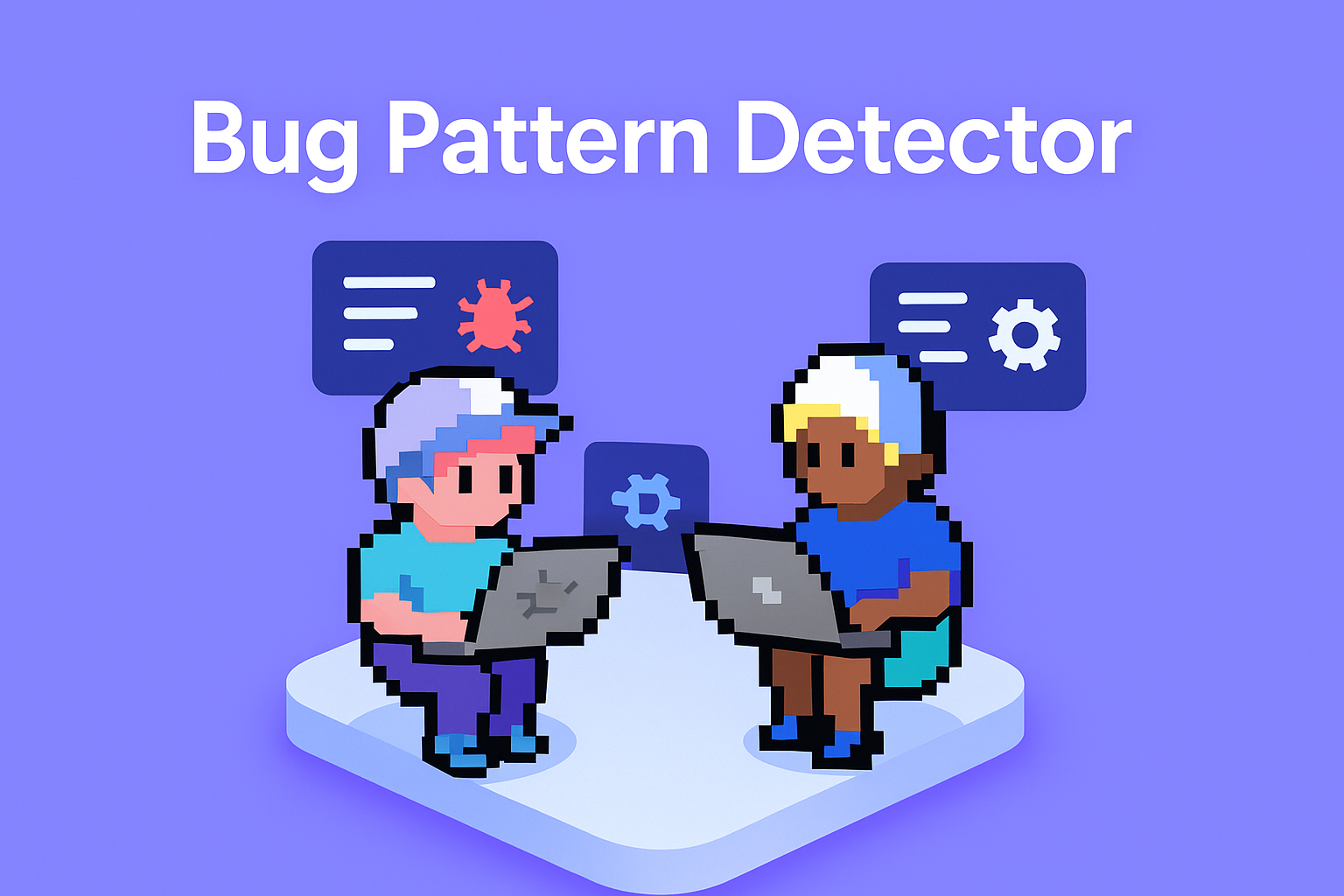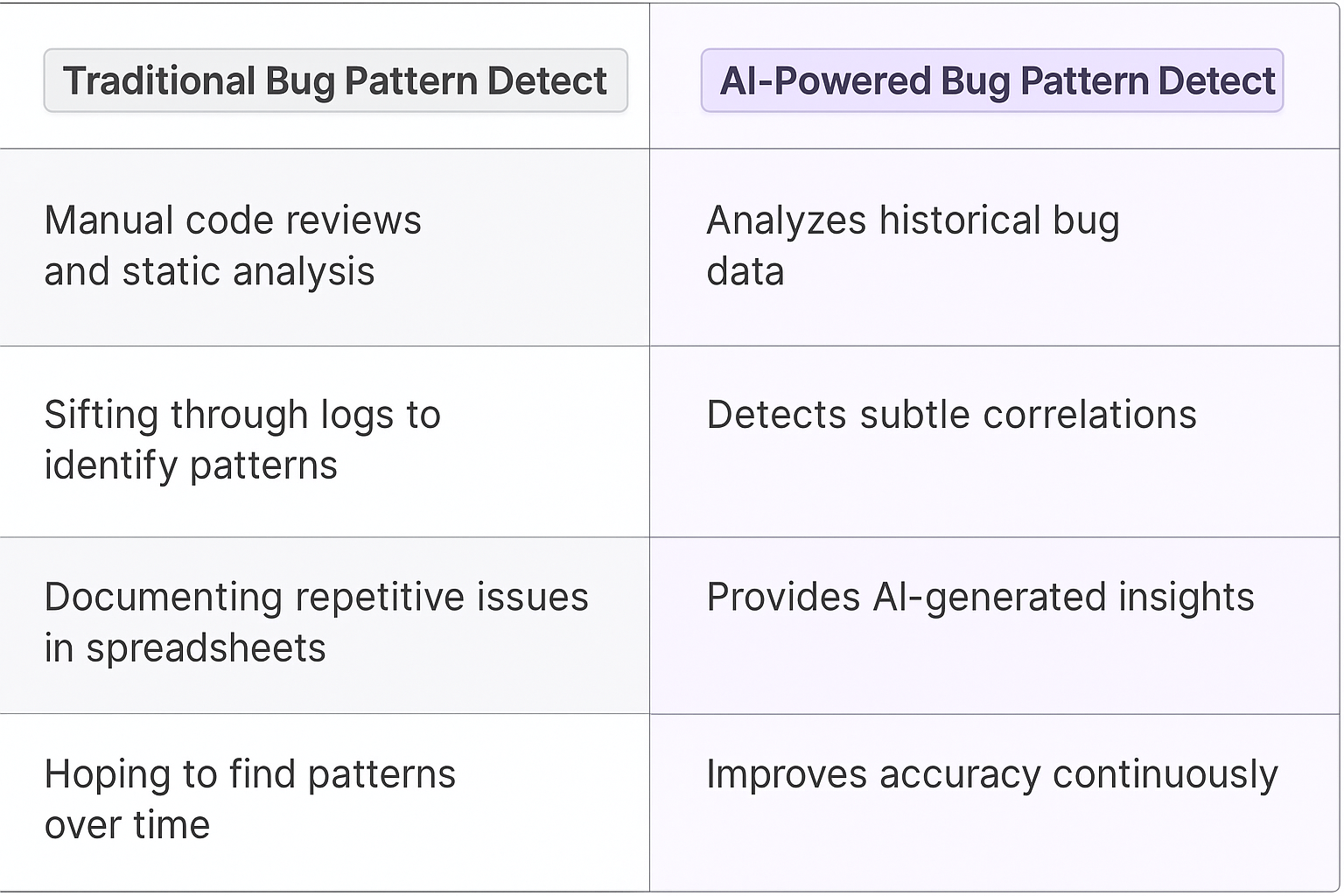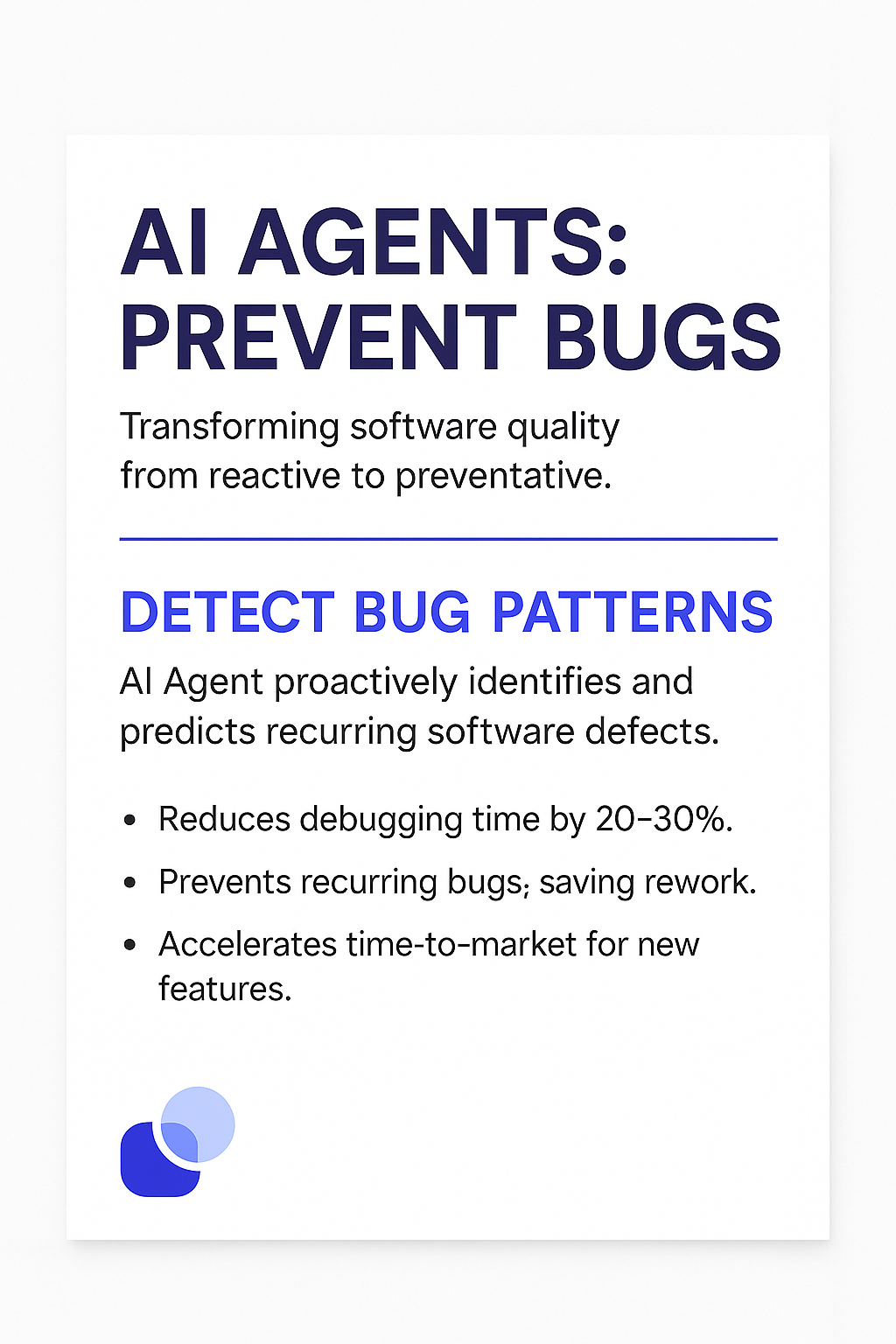Bug Pattern Detector AI Agents
Understanding Bug Pattern Detection Through AI
What is Bug Pattern Detector?
Bug Pattern Detector is a sophisticated AI-powered system that continuously analyzes codebases, identifying recurring error patterns and potential issues before they manifest in production. Unlike traditional static analysis tools, it learns from historical bug data and developer feedback, building an increasingly accurate model of what constitutes problematic code patterns. The system operates as a digital teammate, working alongside developers to maintain code quality and prevent recurring issues.
Key Features of Bug Pattern Detector
- Pattern Recognition Engine: Advanced algorithms that identify subtle correlations between code structures and bug occurrences
- Historical Analysis: Deep learning capabilities that leverage past bug data to predict potential issues
- Real-time Monitoring: Continuous code analysis during development and production phases
- Adaptive Learning: Self-improving systems that become more accurate with each bug encountered
- Cross-language Analysis: Pattern detection across different programming languages and frameworks

Benefits of AI Agents for Bug Pattern Detection
What would have been used before AI Agents?
Traditional bug detection relied heavily on manual code reviews and static analysis tools that often missed subtle patterns. Development teams spent countless hours sifting through logs, trying to connect seemingly unrelated issues, and documenting repetitive bugs. The process was like trying to solve a complex puzzle with pieces scattered across different rooms - time-consuming and frequently frustrating.
QA engineers would maintain spreadsheets of known issues, hoping to spot patterns through brute force documentation. They'd rely on their memory and experience to identify similar bugs across different sprints or projects. This approach left teams vulnerable to recurring issues and made it challenging to prevent future occurrences.
What are the benefits of AI Agents?
AI-powered bug pattern detection fundamentally transforms how development teams handle quality assurance. These digital teammates analyze vast amounts of historical bug data, identifying subtle correlations that human analysts might miss. They're particularly effective at recognizing patterns in:
- Code structure anomalies that consistently lead to failures
- User behavior sequences that trigger specific bugs
- Environmental conditions associated with system instability
- Time-based patterns in application performance degradation
The real game-changer is how these AI agents learn from each new bug discovered. They build sophisticated pattern recognition models that become more accurate over time. When a new issue appears, they can instantly cross-reference it against thousands of historical cases, providing developers with valuable context and potential solutions.
For engineering teams, this means dramatically reduced debugging time. Instead of starting from scratch with each new bug report, developers receive AI-generated insights about similar past issues, their root causes, and successful resolution strategies. This pattern recognition capability helps teams move from reactive bug fixing to proactive prevention.
Most importantly, these AI agents serve as institutional memory for development teams. They preserve and learn from every bug encounter, creating a continuously evolving knowledge base that makes each team member more effective at addressing quality issues.
Potential Use Cases of AI Agents with Bug Pattern Detection
Processes
- Continuous code analysis during development sprints, flagging recurring error patterns before they reach QA
- Historical bug analysis across multiple repositories to identify systemic issues in coding practices
- Integration with CI/CD pipelines to catch pattern-based vulnerabilities early in the development cycle
- Real-time monitoring of production logs to detect emerging bug patterns affecting user experience
- Cross-team knowledge sharing by documenting and distributing identified bug patterns and their solutions
Tasks
- Analyzing stack traces to identify common failure points and suggest preventive measures
- Correlating user reports with code changes to pinpoint bug-introducing commits
- Generating detailed reports on bug patterns specific to different programming languages or frameworks
- Creating automated test cases based on discovered bug patterns to prevent regression
- Prioritizing bug fixes based on pattern frequency and potential business impact
- Scanning pull requests for code changes that match known problematic patterns
- Building a knowledge base of bug patterns and their corresponding fixes for faster resolution
The Network Effects of Bug Pattern Detection
When we look at bug pattern detection through the lens of network effects, we see a fascinating compound growth in value. Each development team that adopts these digital teammates creates a flywheel effect - more detected patterns lead to better detection algorithms, which in turn attract more development teams.
The most successful engineering organizations I've worked with treat bug pattern detection as a living system. They don't just collect data; they build institutional memory. Every pattern detected becomes part of a larger narrative about code quality and technical debt.
What's particularly compelling is how this scales across different programming languages and frameworks. The patterns discovered in a Node.js application often have conceptual twins in Python or Java codebases. This cross-pollination of knowledge creates a multiplier effect that's particularly powerful in enterprise environments.
The key insight here is that bug pattern detection isn't just about finding problems - it's about creating a feedback loop that makes entire engineering organizations smarter over time. The best implementations become central nervous systems for code quality, not just tools.

Industry Use Cases
Bug Pattern Detector AI agents represent a significant shift in how development teams tackle software quality. The ability to detect subtle patterns in bug occurrences transforms the debugging process from reactive firefighting into strategic problem prevention. These digital teammates analyze historical bug data, code changes, and system behaviors to surface insights that even experienced developers might miss.
The applications span well beyond traditional software development. Financial services firms deploy these agents to catch potential issues in trading algorithms before they impact live markets. Gaming studios use them to identify gameplay bugs that could affect user experience and retention. Healthcare technology providers leverage pattern detection to ensure their medical software maintains compliance while catching edge cases that could impact patient care.
What makes these implementations particularly powerful is their ability to learn and adapt. As development teams fix bugs and document solutions, the pattern detection becomes increasingly sophisticated. This creates a compounding effect where each resolved issue makes the system better at preventing similar problems in the future.
Software Development Teams Catch Critical Issues Earlier
The most impactful application of Bug Pattern Detector AI agents emerges in large-scale software development teams working on complex applications. Take Spotify's engineering team - they push thousands of code changes daily across their microservices architecture. A Bug Pattern Detector becomes their proactive debugging partner, analyzing historical bug reports, code commits, and system logs to identify subtle patterns that often escape human detection.
When the engineering team at Spotify implemented a pattern detection system, they discovered that 23% of their critical production issues stemmed from similar root causes that occurred in different parts of their codebase. The AI agent started flagging these patterns during code review, before deployment. For example, it identified that specific API call sequences in their recommendation engine consistently led to memory leaks when paired with certain data structures.
The real magic happens in the learning loop - as developers fix bugs, the AI agent builds a more sophisticated understanding of problematic code patterns. It's like having a senior developer who remembers every bug ever fixed, but can process new code in milliseconds. Within three months of implementation, Spotify's team reported a 47% reduction in production hotfixes and a 31% decrease in customer-reported issues.
Beyond just finding bugs, these AI agents reshape how development teams think about code quality. They create a continuous feedback cycle where developers learn to write more resilient code by understanding the patterns that historically led to issues. This shifts the debugging paradigm from reactive firefighting to proactive prevention.
The ROI becomes clear when you consider that the average cost of a production bug ranges from $1,500 to $10,000 in engineering time alone. By catching these issues during development, teams save both money and maintain their shipping velocity without sacrificing reliability.
E-commerce Platforms Prevent Revenue-Impacting Code Issues
I've been tracking how major e-commerce platforms deploy Bug Pattern Detector AI agents, and Shopify's implementation stands out as particularly clever. Their engineering teams handle millions of transactions daily across hundreds of thousands of stores, making traditional QA approaches insufficient for catching subtle payment processing bugs.
The Bug Pattern Detector they implemented focuses specifically on transaction-critical code paths. It analyzes patterns across their payment gateway integrations, shopping cart logic, and checkout flows. What's fascinating is how it correlates seemingly unrelated issues - for instance, it identified that certain combinations of discount codes and shipping calculations were triggering edge cases that caused order total miscalculations.
The numbers tell a compelling story: After six months of running the AI agent, Shopify's teams caught 89% of potential payment processing bugs before they hit production. More impressively, they reduced checkout-related customer support tickets by 64%. When you're processing billions in GMV, even a 0.1% reduction in transaction errors translates to massive savings.
But the real growth hack emerged in an unexpected place - the AI agent started identifying patterns in how different regions and currencies handled decimal point calculations differently. This insight led to a complete overhaul of their money handling library, preventing what could have been millions in transaction discrepancies.
The network effects are particularly interesting here - as more merchants join the platform, the AI agent gets better at identifying problematic patterns specific to different types of e-commerce businesses. A bug pattern that appears in one fashion store's checkout flow can help prevent similar issues in thousands of other stores before they manifest.
For e-commerce platforms, where every minute of downtime or every transaction error directly impacts revenue, these AI agents aren't just tools - they're essential infrastructure for maintaining trust and reliability at scale.

Considerations & Challenges
Building an effective Bug Pattern Detector AI Agent requires navigating several complex technical and operational hurdles. The implementation process demands careful attention to both the underlying architecture and the practical realities of software development environments.
Technical Challenges
Pattern recognition accuracy remains one of the most significant technical hurdles. Bug patterns often manifest differently across various codebases, frameworks, and languages. Training the AI model requires massive datasets of verified bug patterns while avoiding false positives that could waste developer time.
The detector must also handle context-switching between different programming paradigms and maintain performance at scale. When analyzing millions of lines of code, the agent needs sophisticated memory management and processing optimization to deliver results in reasonable timeframes.
Operational Challenges
Developer workflow integration presents a crucial operational challenge. The bug pattern detector needs to operate seamlessly within existing development environments without disrupting established processes. This includes managing notification timing and frequency to prevent alert fatigue.
False positive management becomes increasingly important as the system scales. Even a 1% false positive rate can overwhelm development teams when analyzing large codebases. The agent must incorporate feedback mechanisms allowing developers to flag incorrect pattern matches, creating a continuous learning loop.
Implementation Considerations
Success depends heavily on proper configuration and customization for each development environment. Teams need to define clear severity thresholds and establish escalation protocols for different types of detected patterns. The agent should also maintain detailed audit trails of detected patterns and resolutions for compliance and improvement analysis.
Privacy and security considerations cannot be overlooked. The bug pattern detector requires access to source code and potentially sensitive information, necessitating robust security controls and data handling protocols. Teams must carefully balance detection capabilities with data protection requirements.
Evolution and Impact of AI-Powered Software Quality Assurance
The adoption of Bug Pattern Detector AI agents marks a significant evolution in software development practices. Through network effects and continuous learning, these systems create compound value that extends beyond simple bug detection. Development teams using these digital teammates consistently report dramatic reductions in debugging time, fewer production issues, and improved code quality. As the technology matures, we'll likely see even more sophisticated applications, particularly in critical systems where reliability is paramount. The key to success lies in treating these AI agents not just as tools, but as integral members of the development team, contributing to a culture of quality and continuous improvement.











